Albert Dros has been a great friend to Lonely Speck over the last few years, sharing with us his experiences shooting landscape astrophotography around the world. We had the pleasure of meeting him in his native environment of the Netherlands when we traveled through Europe last spring. A few weeks ago, Albert messaged me about his plans to photograph the Milky Way behind an erupting volcano. In this article, Albert Dros recounts his personal experience planning and shooting the Fuego Volcano in Guatemala.
The Idea
Nature has lots to offer for landscape photographers. We love to shoot nature’s paintings. Storms, rainbows, tornadoes, lightning strikes: they’re all a gift from nature that we can play with as a landscape photographer. Volcanoes are one of them, too, especially when they’re erupting. I have been fascinated by volcanoes; they have been on my list to shoot for quite a while. My younger brother recently went to Guatemala for some backpacking and learning the Spanish language. When he sent me some photos of an erupting volcano, my photography senses were immediately triggered. The erupting volcano was called ‘Fuego’ (literally “Fire”). I managed to find webcams and activity on scopes and checked how active Fuego was. According to the history, the volcano has remained quite active, but you had to be lucky to see a lot of eruptions. Still, the idea of meeting up with my brother and shooting a volcano seemed like a good enough reason to go.
The Plan
When I decided I wanted to go to Guatemala to try and shoot the volcano, I started doing my research on how I wanted my shot to look. Erupting lava is best visible in evening and night, so I was obviously going for that. I researched other shots from this volcano. Most good shots were during a full moon so that you could see the scenery well, lit by the full moon in combination with the lava eruptions. I wanted to try something different. I have always been intrigued with planning and photographing the Milky Way at particular locations. How awesome would it be to shoot the erupting volcano with the Milky Way?
I checked from what angle I would be able to see the erupting volcano. The place from which I was going to be shooting was the (inactive) neighbour volcano Acatenango. It’s possible to hike up to the top of this Acatenango for a good view of the active Fuego. I planned the shot with the PhotoPills app, and to my excitement this shot was actually possible. In the last week of March, around 3 AM, the Milky Way galactic center would be in a good position right next to the volcano. By planning on PhotoPills and visualising the view in my head, I could see how the optimal shot would unfold.
I made my plan a few weeks before going to Guatemala, targeting the date of 30 March, 2017. Should the conditions change, the plan wouldn’t differ too much for the other days around my target date.
While I made my plan with a private Alpha version of PhotoPills for Android, PhotoPills has since released a public Beta for Android users.
What I Needed
So what did I need to get the shot?
1) The right date for the Milky Way to rise next to the Fuego volcano, as seen from the Acatenango volcano
2) A clear night free of cloud cover
3) Date close to new moon for good visibility of the stars
4) Most importantly: luck. I wanted lava eruptions at the right times of the evening
I figured it would be extremely difficult to get both the stars and the lava properly exposed in one exposure because of the huge contrast difference. To get the perfect balance of exposure, I thought I would have to shoot during late blue hour at sunset or early blue hour at sunrise. When planning a trick shot like this, there are a lot of factors I considered. I always like to plan everything that can be planned.
When I succeed in making a difficult landscape shot, people often say “wow, you were so lucky.” They’re often actually right. In the end you always need that extra bit of luck for everything to fall into place. But ultimately, I try to keep the chances as good as possible with careful planning. For example: checking scopes and webcams every day to ‘get to know’ the volcano and calling the weather station multiple times to improve my awareness of the chances of getting a successful shot.
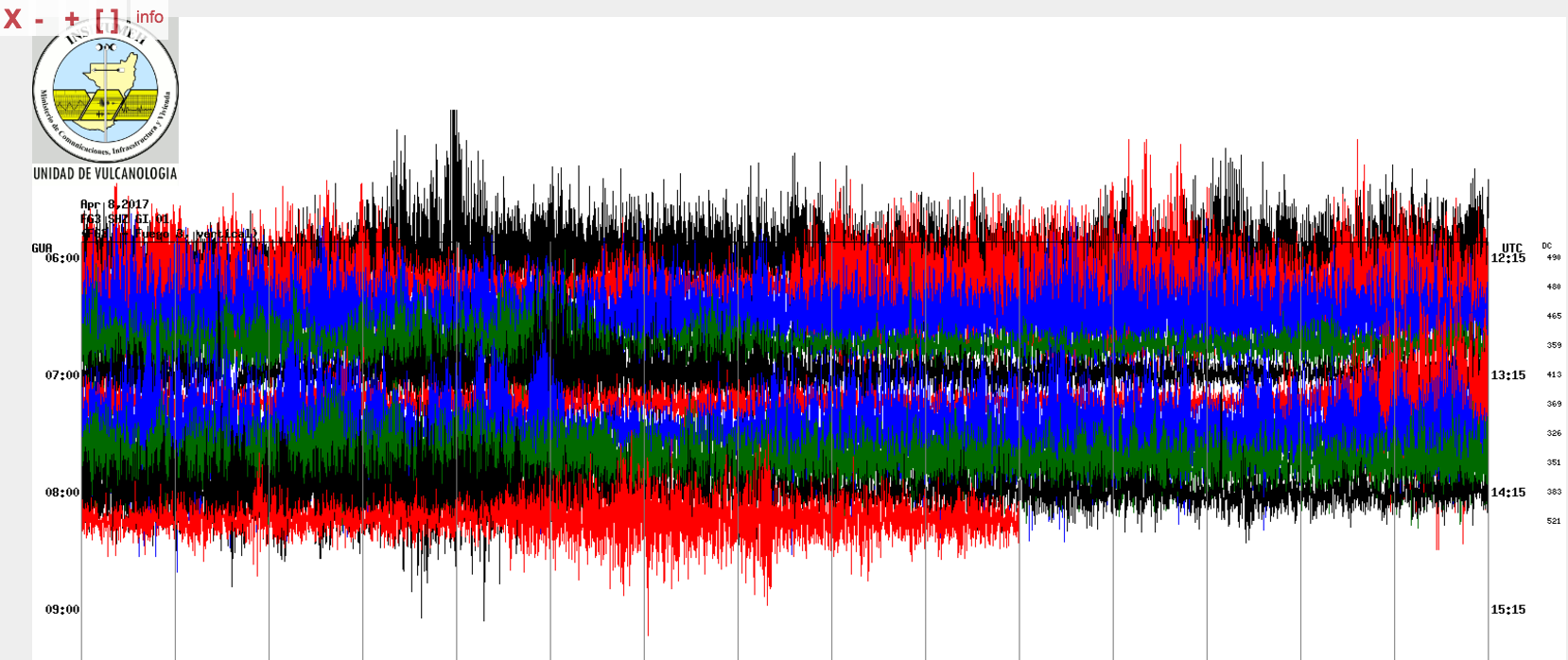
The Trip
A few weeks later, after a nearly 30 hour plane trip including transfers, I found myself in Antigua, Guatemala, a nice town close to the Fuego volcano. From the town, I could see the top of the Fuego blowing smoke with occasional rumbling.
Checking the seismograph activity online showed that, in the days during my travel to Guatemala, the volcano had been very active. We called the weather station multiple times that day to ask their thoughts on what day would be best to climb the adjacent Acatenango volcano in regards to both volcanic activity of Fuego and for clear skies. According to the station, the weather predictions for the next day looked good and it would be the best day to try our luck. I was originally planning on getting a day of rest in Antigua before climbing the volcano but I knew I had to move fast.
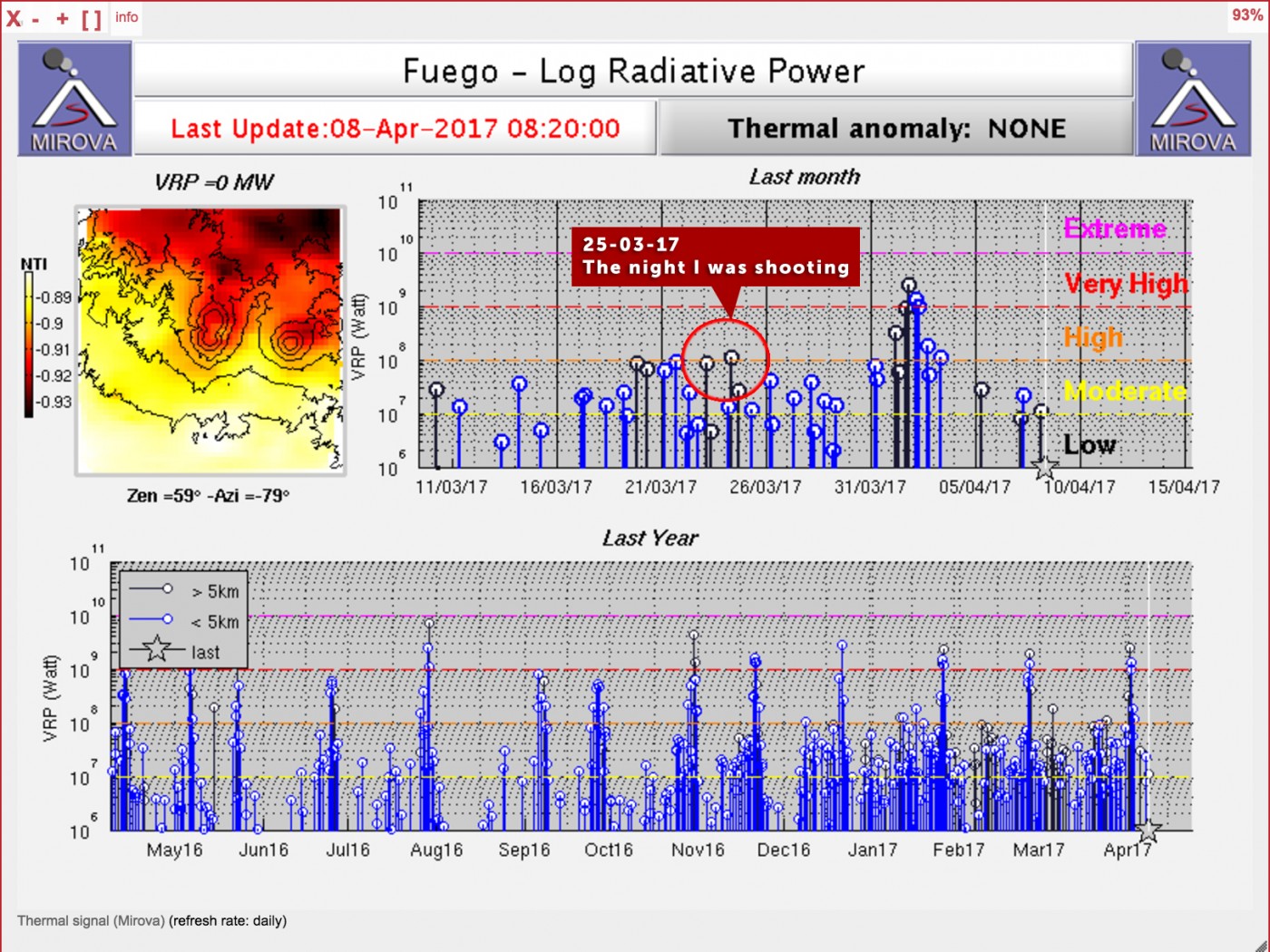
Gear
I knew the hike wasn’t going to be easy so I had to keep my gear relatively light while still maintaining great image quality. I also heard stories about bandits robbing tourists on the volcanoes in Guatemala and those stories worried me the most as I was bringing expensive gear. I chose to put my camera gear in a super worn out bag that didn’t look like a camera bag at all. I figured that with a relatively light and small kit, I wouldn’t stand out. I needed a tripod, but not one that would scream ‘I’m a photographer’ so I brought a small Mefoto travel tripod that I borrowed from my friends at Benro. It was small enough that it could fit in my backpack such that no one would see it. Here’s the final list of camera gear that I brought up to the volcano:
- Sony a7RII body (Amazon / B&H)
- Sony Zeiss 16-35 f/4 (Amazon / B&H) (for general shots)
- Sony Zeiss 55 f/1.8 (Amazon / B&H) (for tighter shots during the night, perfect lightweight prime for nightscapes)
- Sony 85 f/1.8 (Amazon / B&H) (new medium telephoto lens, very small and light, good for tighter shots)
- Samyang/Rokinon 14mm f/2.8 (Amazon / B&H) (my go-to lens for Milky Way nightscape panoramas)
- Mefoto Traveler tripod (B&H)
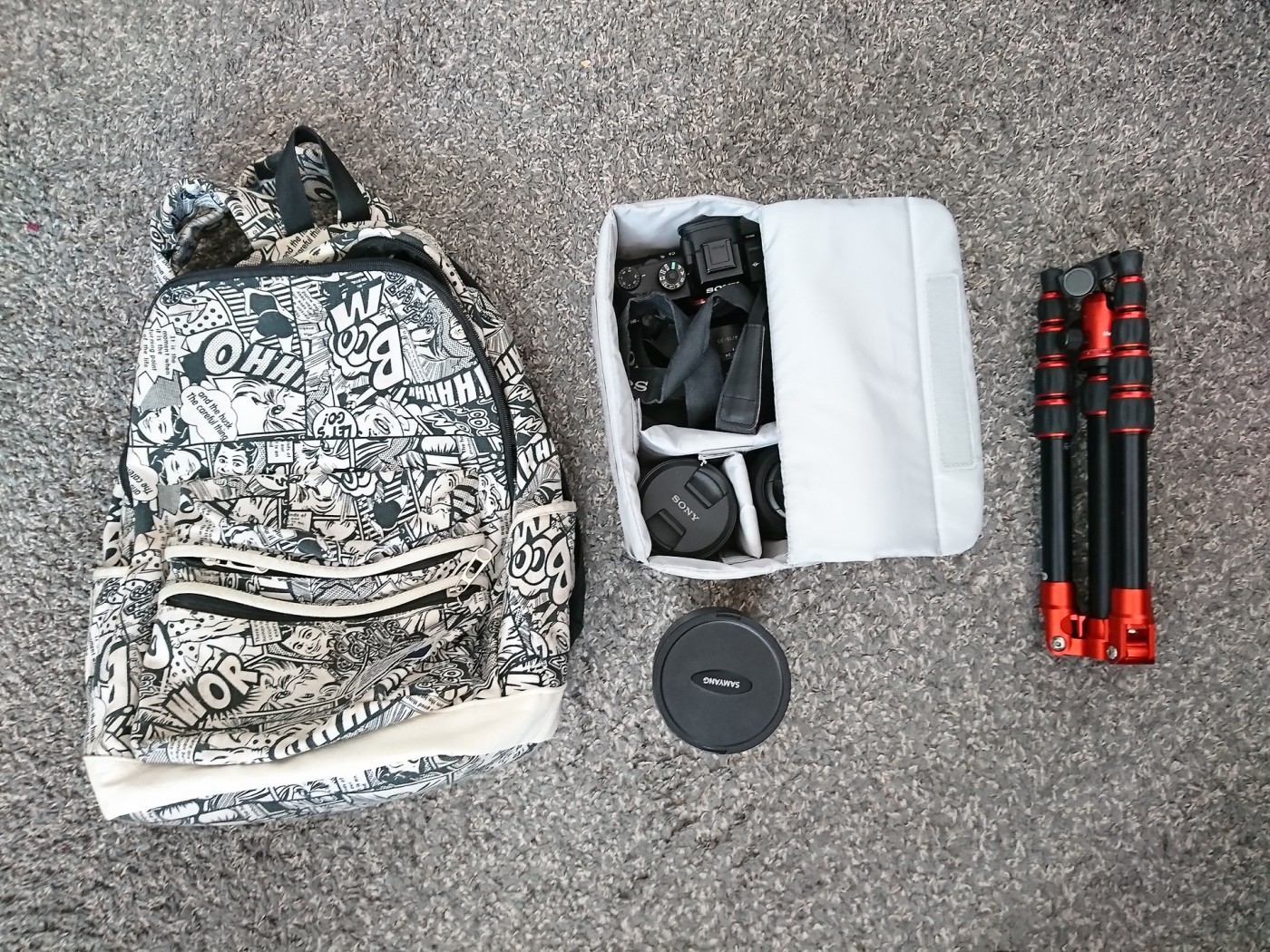
The Shoot
The next day, after a very tough steep hike, I found myself on the Acatenango volcano, arriving to the shooting location just before sunset. Unfortunately, it was very cloudy and I couldn’t even see the Fuego volcano next to me. However, the clouds were moving fast so I hoped it was going to clear up. It did.
When I finally saw Fuego erupt up close, combined with the power of its sound, I was paralysed with awe. It was amazing. It was one of the most impressive things I had ever seen in nature.
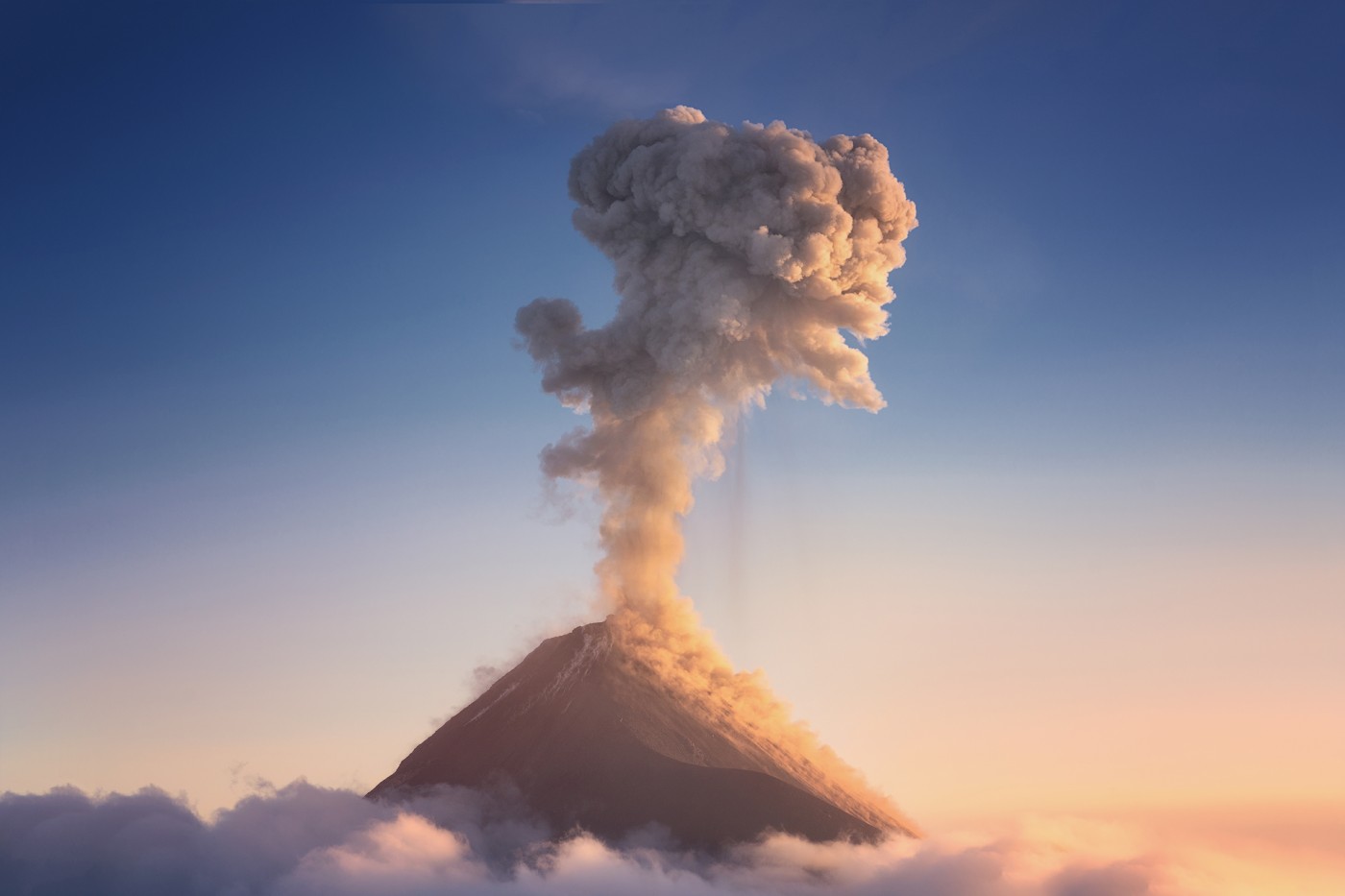
My research paid off. All the elements I needed to create the shot that I wanted seemed to fall into place. It’s a great feeling when things go as planned. The real show started as it got darker: Fuego kept erupting and the glowing lava finally became visible. It was surreal. The sight of an erupting volcano is something I was only used to seeing in movies.
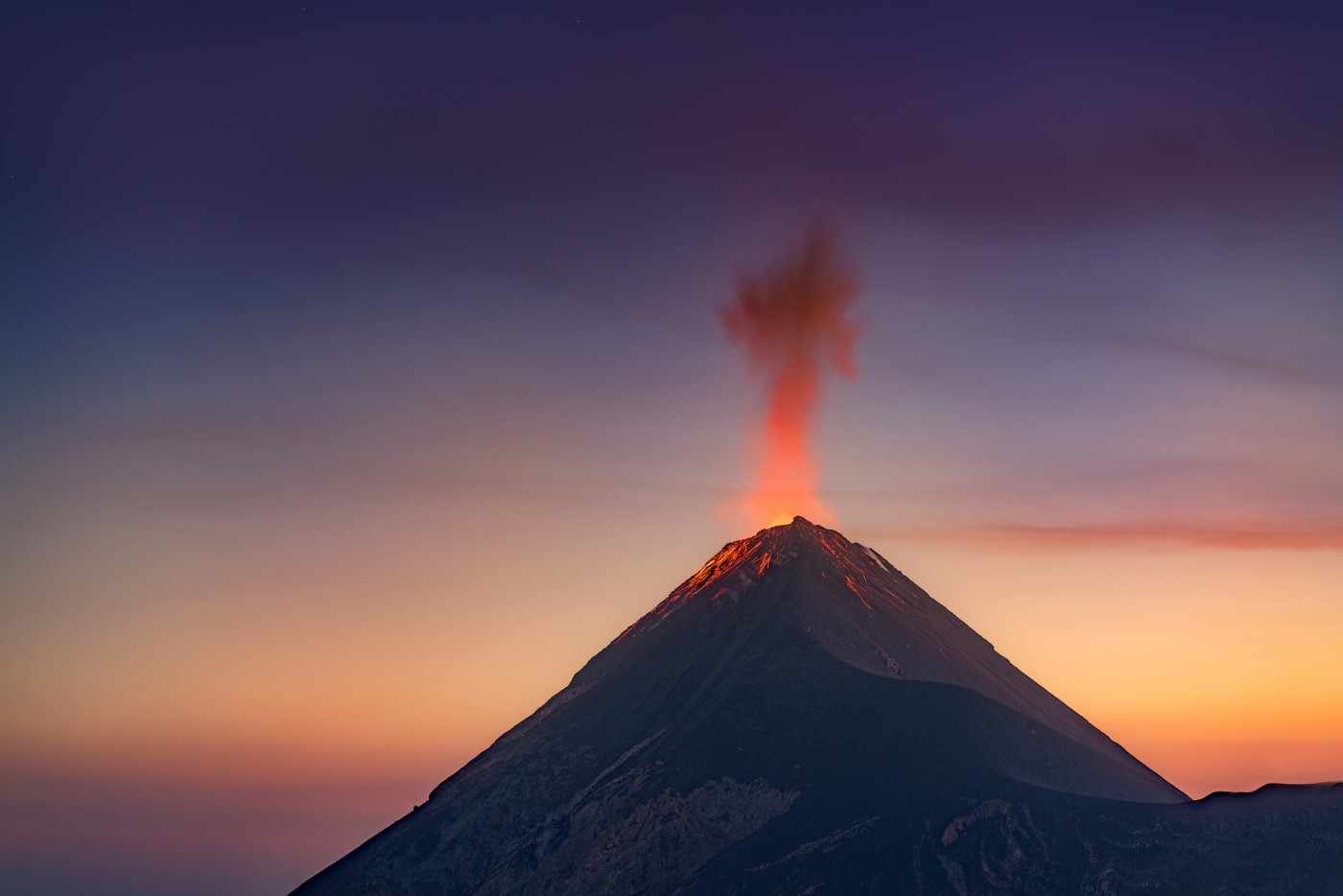
During the blue hour, the volcano unfortunately became calm for a while. Blue hour would have been perfect to shoot the eruptions as the contrast between the sky and the lava would not have been as large. I figured that it would be much more difficult to shoot during the dark hours of the night because of the increased contrast between the bright lava and the dark night sky.
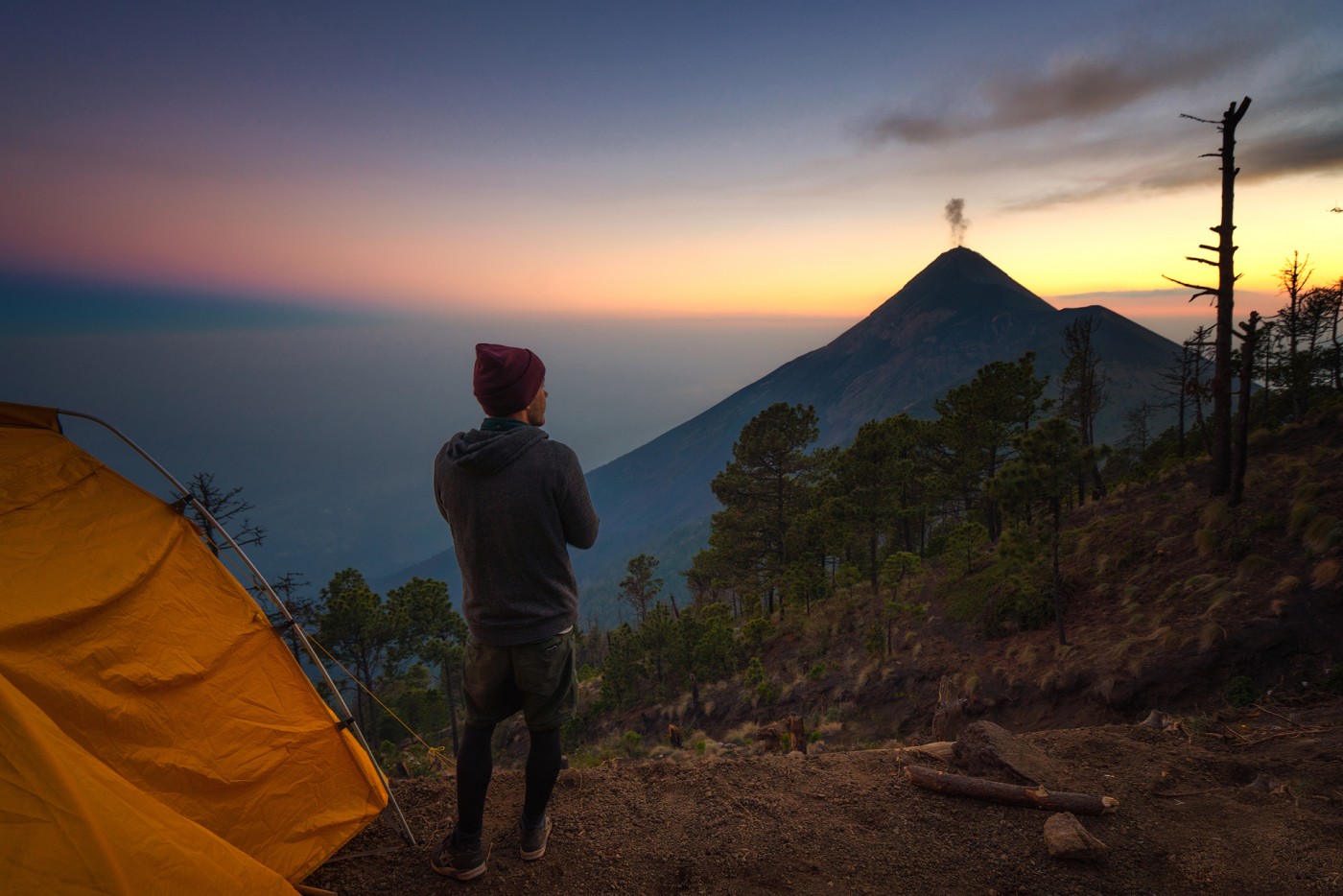
I was right. The pure darkness during the night made for difficult shooting conditions. The huge contrast between the bright lava and the darkness of the night made it extremely difficult to shoot everything in a single exposure. In this early shot, the lava is overexposed while the rest of the image is still very dark.
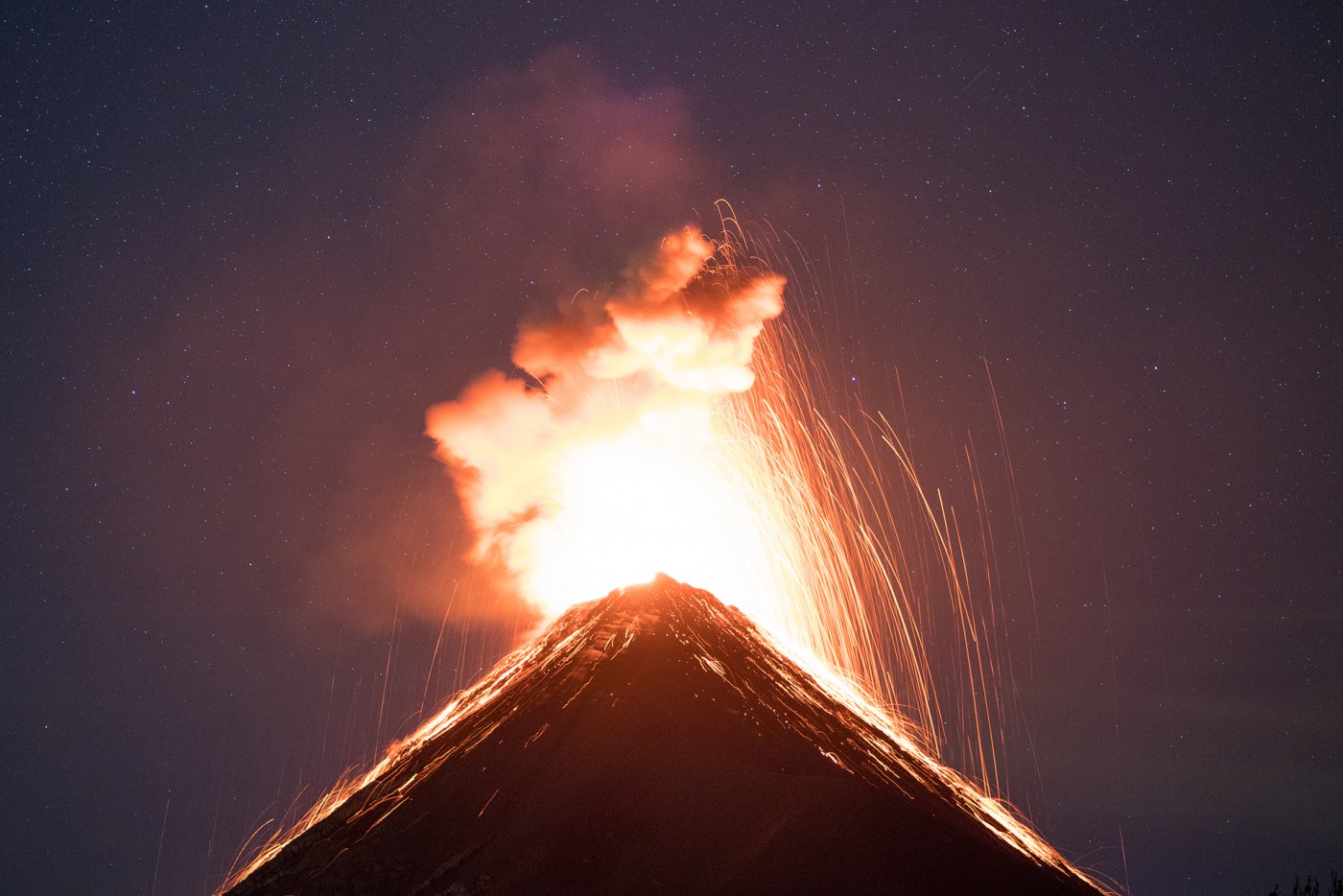
For good close up shots with the Milky May, I knew I had to wait for the early morning blue hour and hope for a good eruption. Only until then, the Milky Way would line up with the volcano. Early in the night, only the fainter parts of the Milky Way were visible off to the left of the volcano.
Even early in the night, the view was nothing short of spectacular. Seeing the Fuego erupt under thousands of stars was unbelievable. Below is a panoramic shot from the view in front of my tent. The volcano on the left is a sleeping volcano called Agua. Agua, water. Fuego, fire. In between these volcanoes are a few little towns. I was surprised to see that these towns did not cause that much light pollution the sky. Luckily, there was some kind of haze layer blocking some of the light pollution, allowing us to see a beautiful starry sky. I knew the best part of the Milky Way would arch across the valley in early morning, but I already found this view amazing.
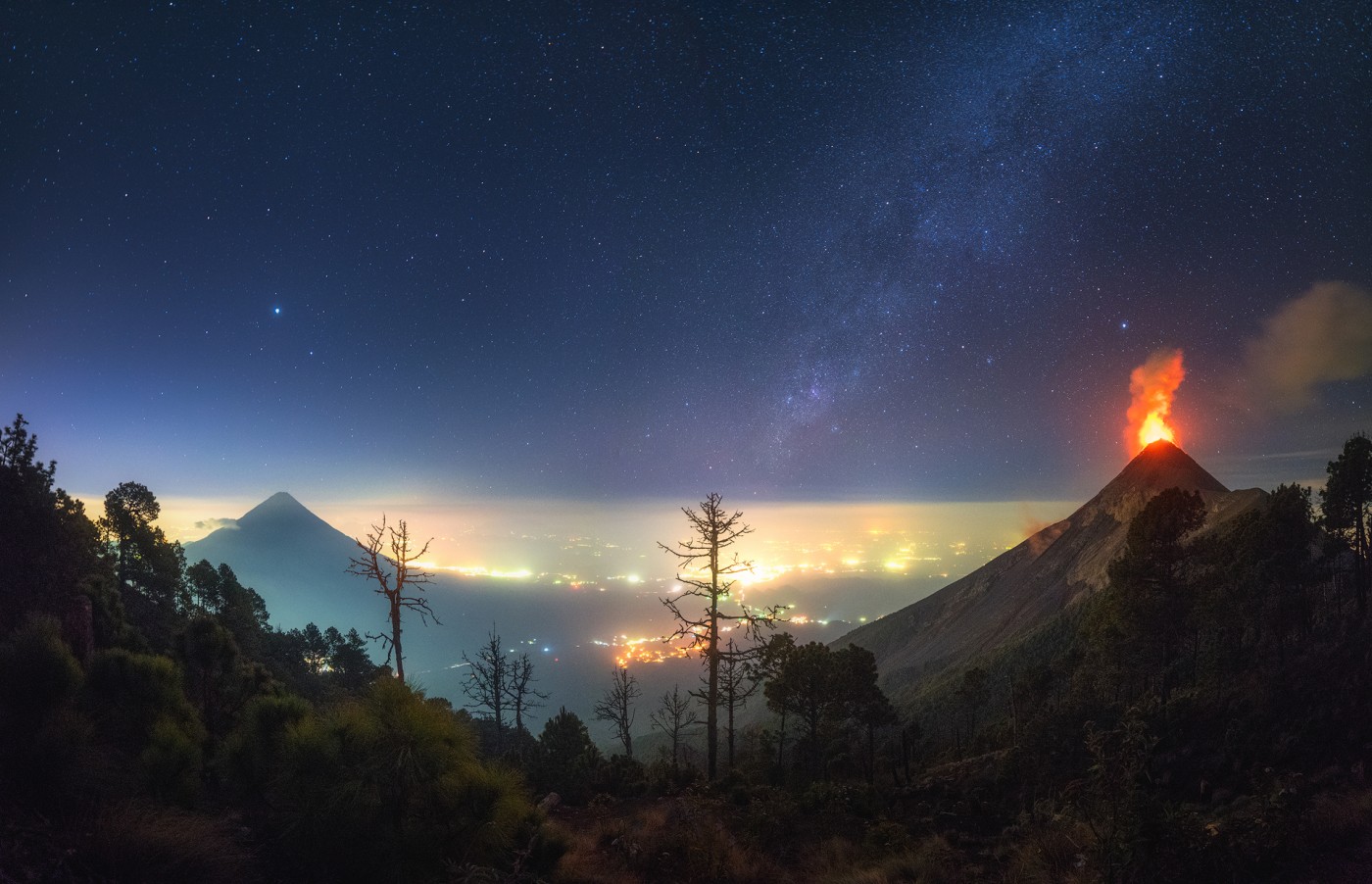
I kept shooting for a while until I decided to get some sleep in my tent around 10 PM. While it was around 30°C (86°F) in Antigua during the day, at 3500 m (11,483 ft) it was below 0° Celsius (32°F). Even though I was prepared, it was still extremely cold. Furthermore, I didn’t get very much sleep as the volcano periodically kept erupting in loud explosions. I eventually woke up around 2 AM for more shooting. As planned, the Milky Way stretched over the valley to the left of Fuego.
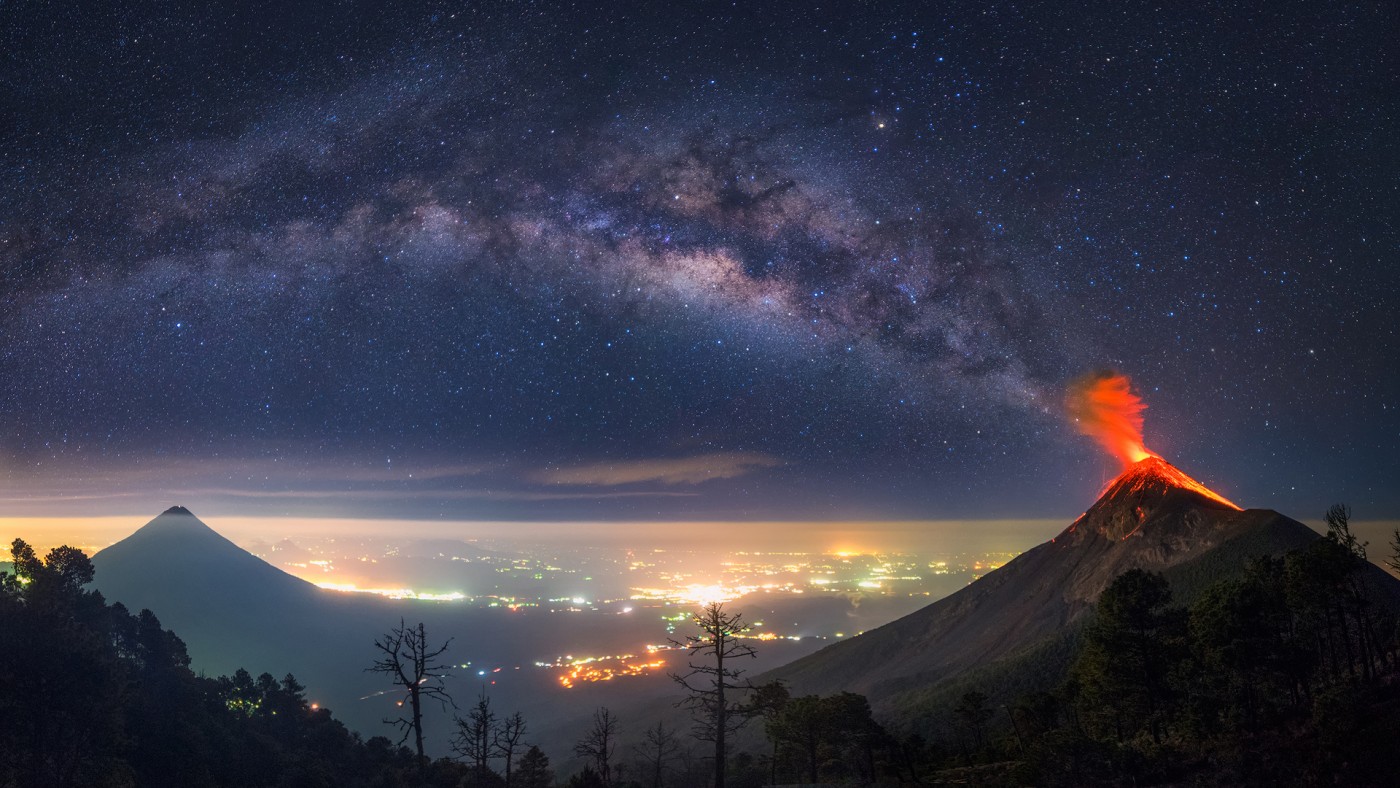
Although all of this was amazing, I wouldn’t be me if I still wasn’t 100% satisfied. As I mentioned before, I really wanted a close up of the erupting volcano with the Milky Way. My best opportunity was that morning. I put my camera in position for the early blue hour when the Milky Way would still be visible. At that time, a very faint crescent moon had risen in the sky, giving me some extra light on the foreground. I set everything up and waited for the right moment. I just needed that right eruption. And then it happened.
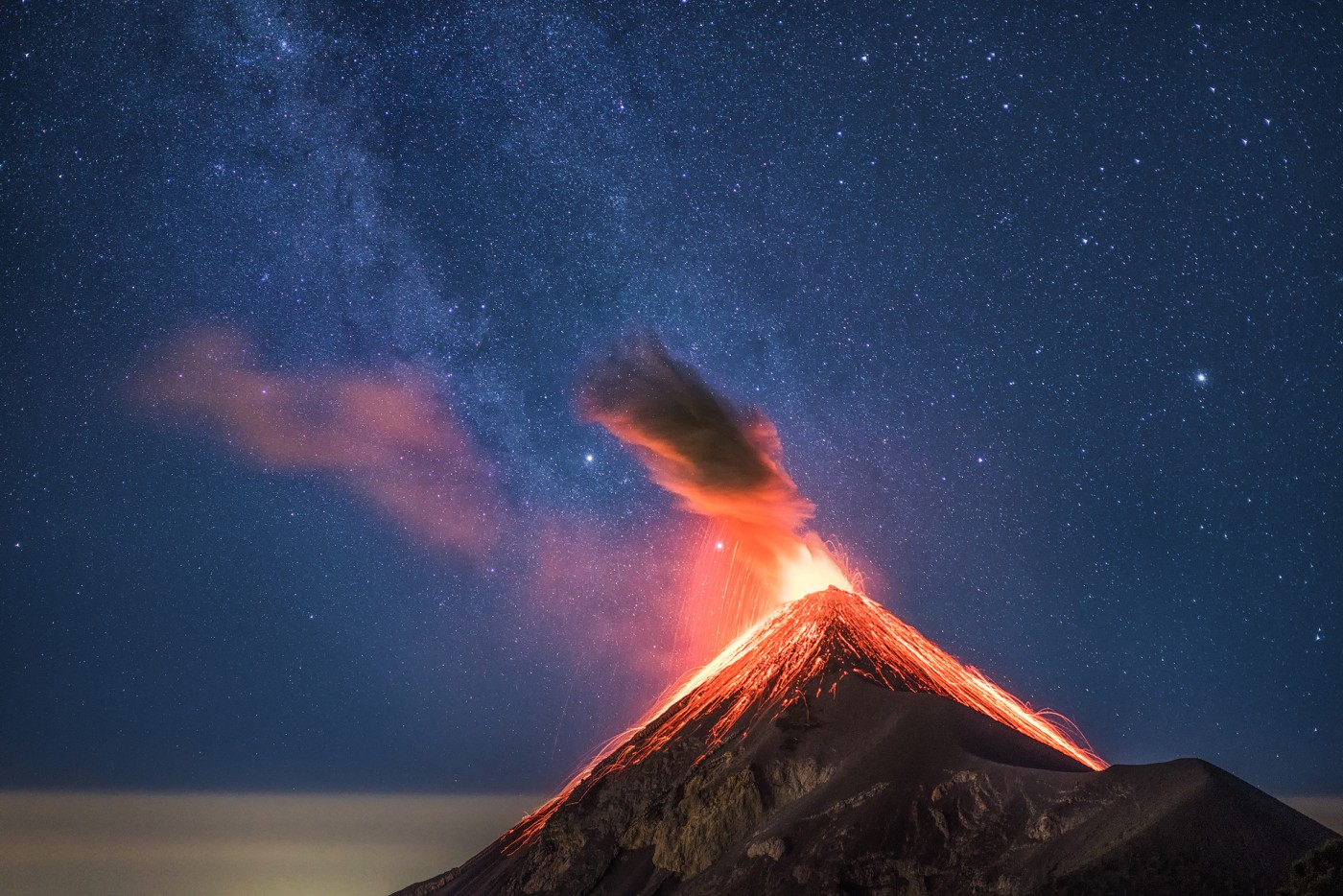
A captured a perfectly timed shutter with the Milky Way in place behind the fiery lava of the erupting Fuego volcano. When I first saw it on my camera screen, I couldn’t believe my eyes. The satisfaction that I got from succeeding in taking what seemed to be an almost impossible shot is hard to describe.
Having the shots I wanted for the night, I enjoyed the warmth of the rising sun not too long afterwards. I was already satisfied so I didn’t shoot too much more, deciding instead to enjoy the moment. After the sun was fully up, the Fuego treated us a final goodbye show with nonstop eruptions that caused the whole valley to be covered in smoke and ash.
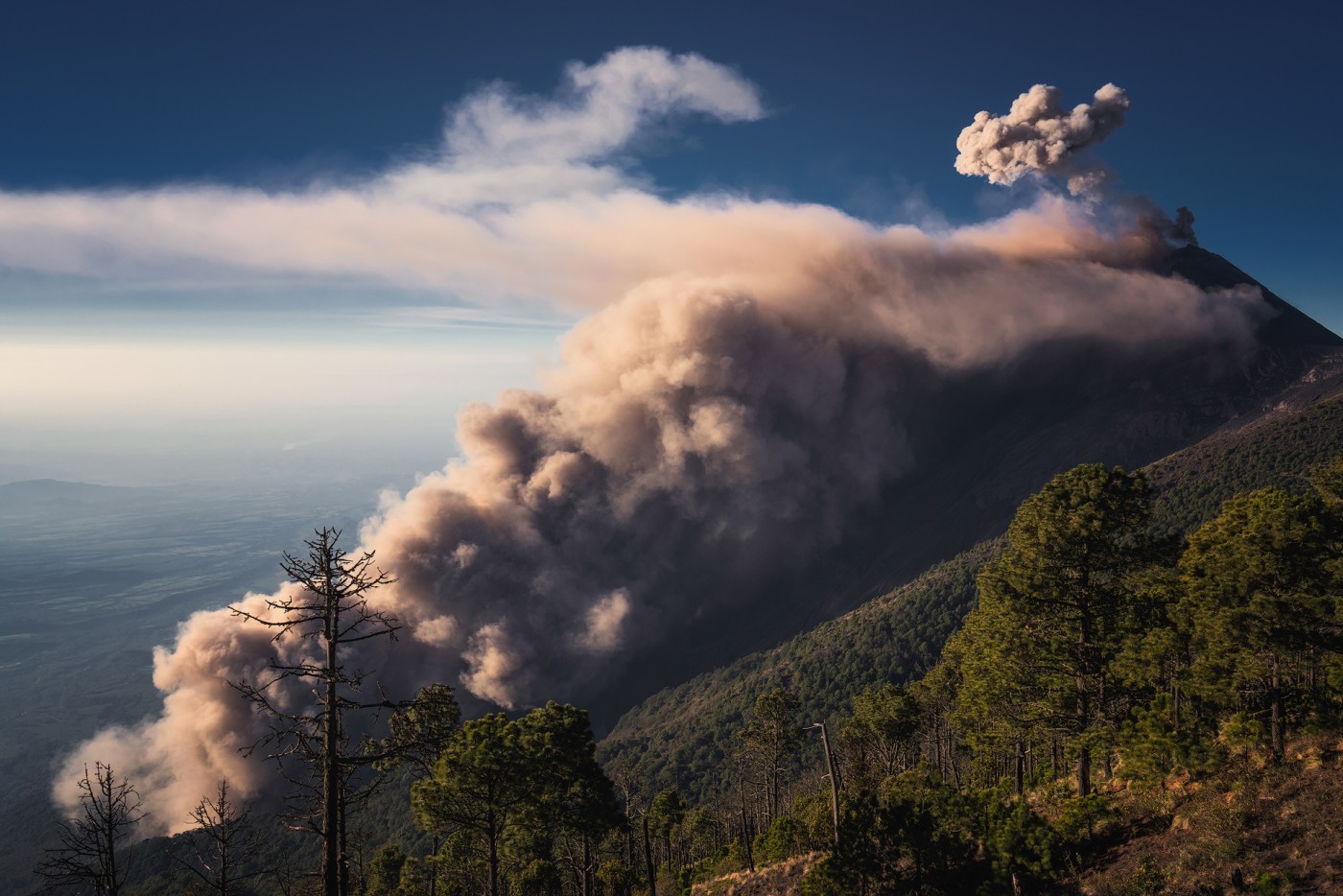
I still feel that all of the images here still don’t do justice to the reality of my experience. Seeing a volcano erupt at night is one of the most beautiful things in nature I have ever seen.
Help Support Us!
We hope that you enjoyed this inspirational article by our guest contributor and great friend, Albert Dros. Check out more of Albert’s spectacular landscape photography and astrophotography on his website: AlbertDros.com and follow Albert’s worldwide travels and photography adventures on his Instagram, Twitter, and Facebook.
All photographs on this page are copyright of Albert Dros. All Rights Reserved.
Disclosure
We are a participant in the Amazon Services LLC Associates Program, an affiliate advertising program designed to provide a means for us to earn fees by linking to Amazon.com and affiliated sites. We are also a participant in the B&H Affiliate Program which also allows us to earn fees by linking to bhphotovideo.com.
Learn Astrophotography
Astrophotography 101 is completely free for everyone. All of the lessons are available on the Lonely Speck Astrophotography 101 page for you to access at any time. Enter your email and whenever we post a new lesson you’ll receive it in your inbox. We won’t spam you and your email will stay secure. Furthermore, updates will be sent out only periodically, usually less than once per week.
Help us help you!
Believe it or not, Lonely Speck is my full-time job. It’s been an amazing experience for us to see a community develop around learning astrophotography and we’re so happy to be a small part of it. I have learned that amazing things happen when you ask for help so remember that we are always here for you. If you have any questions about photography or just want to share a story, contact us! If you find the articles here helpful, consider helping us out with a donation.
[button font_size=”16″ color=”#136e9f” text_color=”#ffffff” url=”https://www.paypal.com/cgi-bin/webscr?cmd=_donations&business=lonelyspeckblog%40gmail.com&item_name=These+tips+help+keep+lonelyspeck.com+running.¤cy_code=USD&source=url” target=”_blank”]Donate[/button]
Thanks so much for being a part of our astrophotography adventure.
-Ian
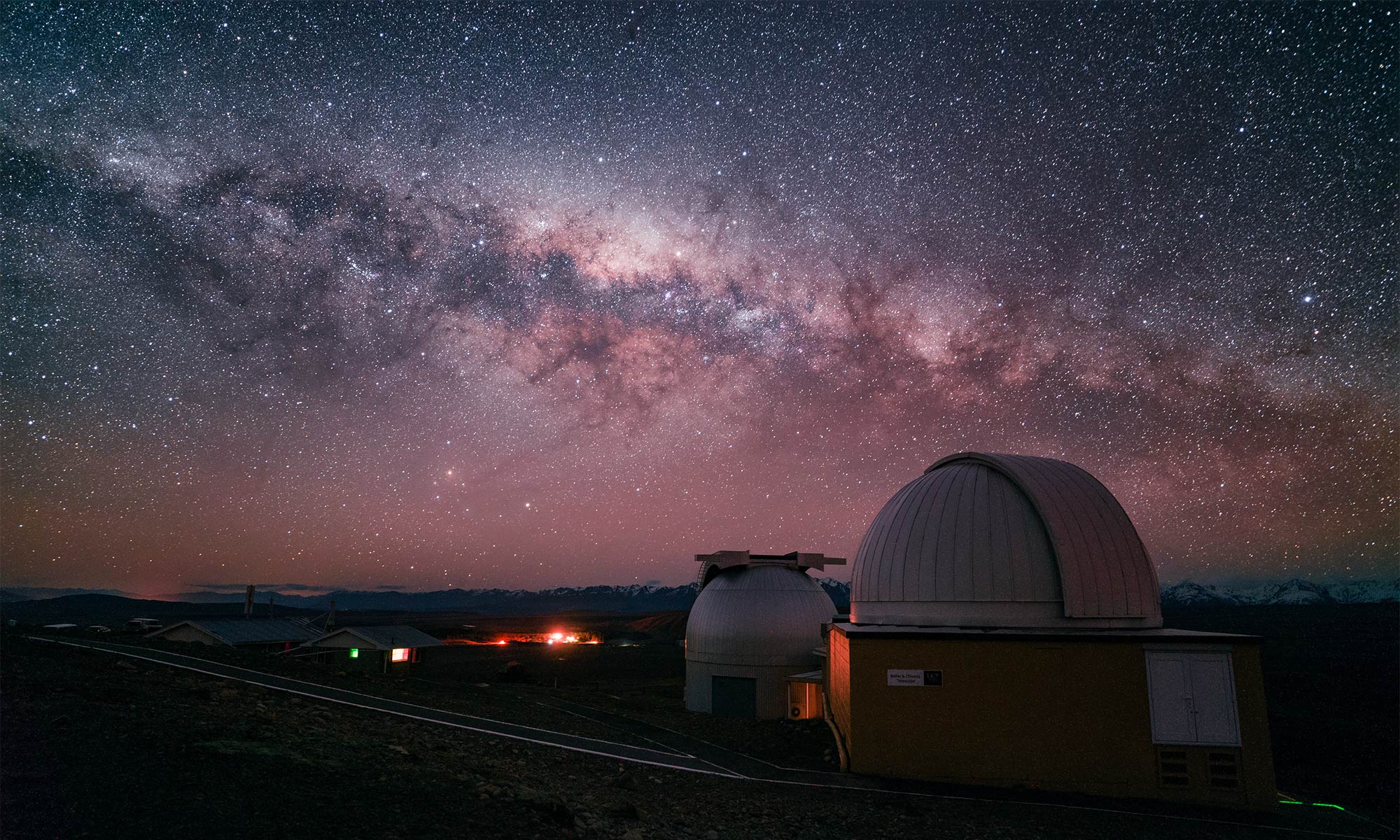
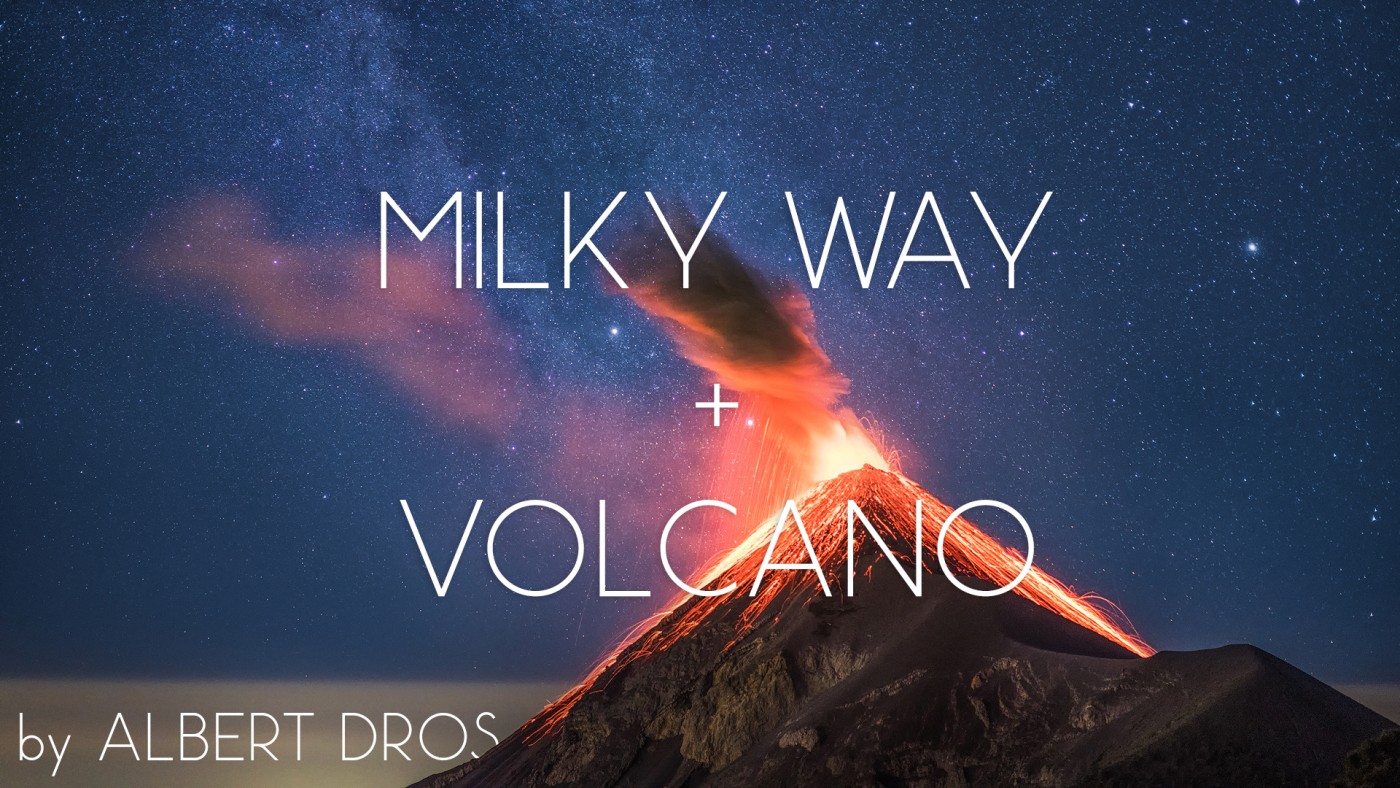

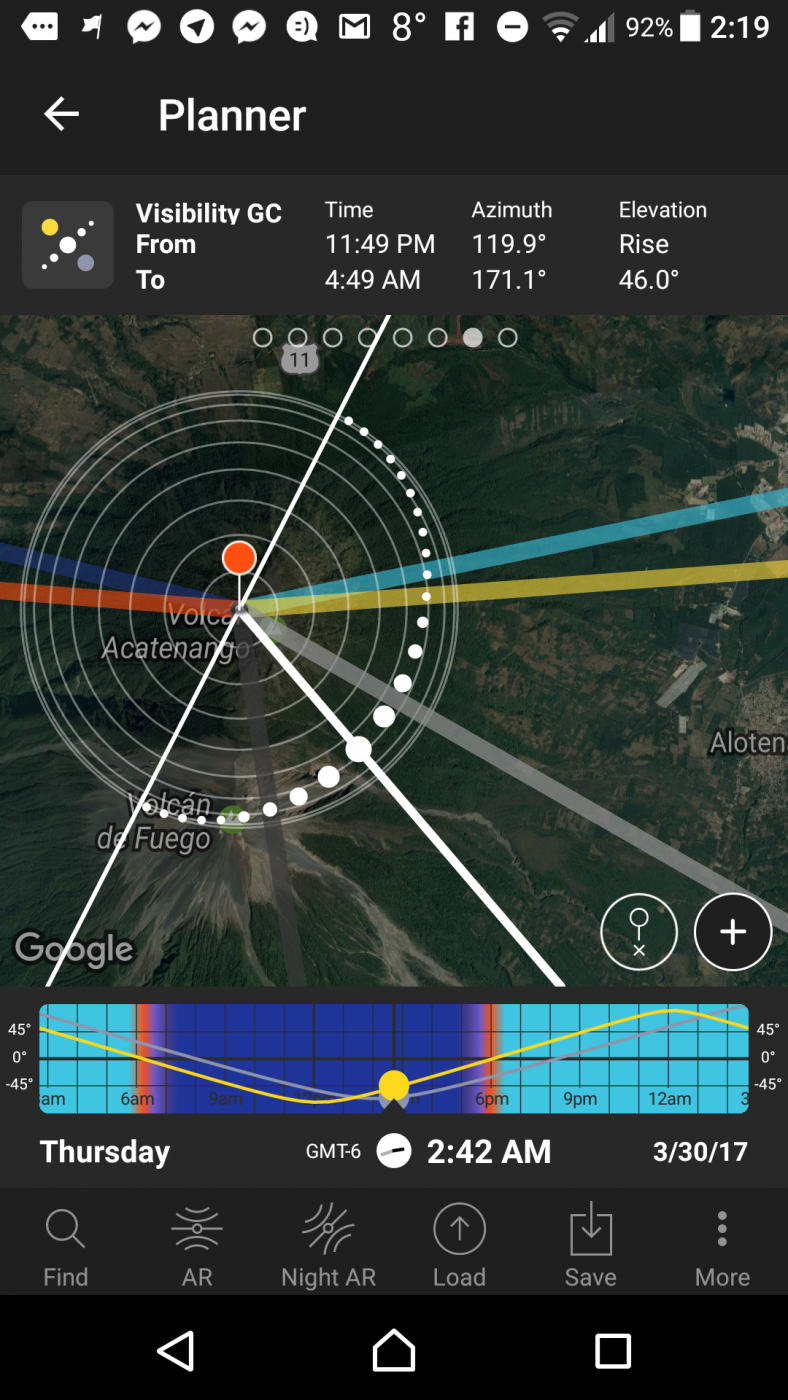
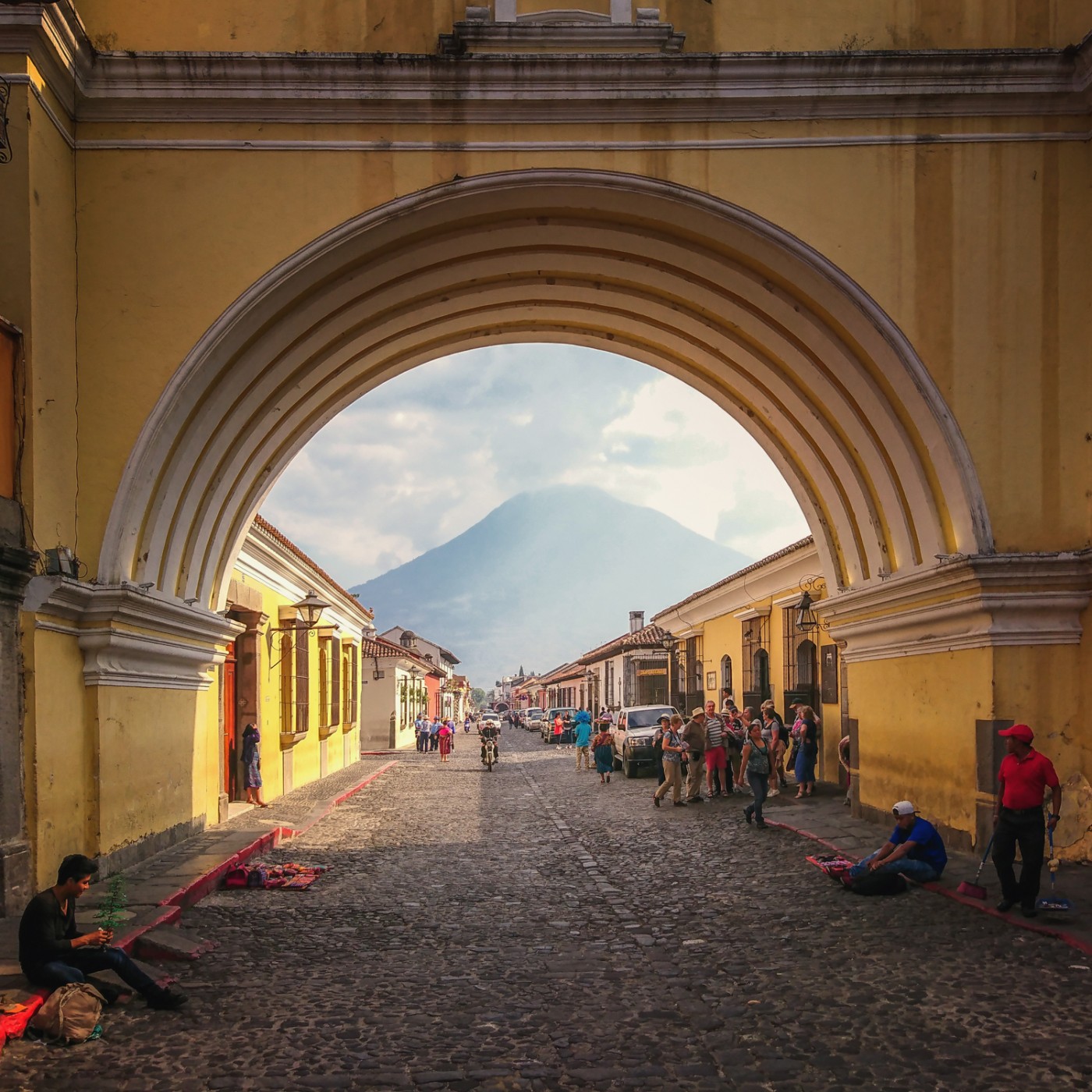
A really fantastic and awe-inspiring account of two extreme aspects of nature – the heavens and the volcano. That is a wonderful idea and the reality must have been much more than any photograph can depict. I love astrophotography and the Milky Way is so lovely, especially as it arches across the spectacular landscapes like that which you have captured.
Wow I’m so glad I came across your post/page about capturing Fuego and the Milky Way!! I’m planning to go beginning of April for my bday and would love to attempt to capture this too! Only issue is the moon phase will be a few days after the full moon…